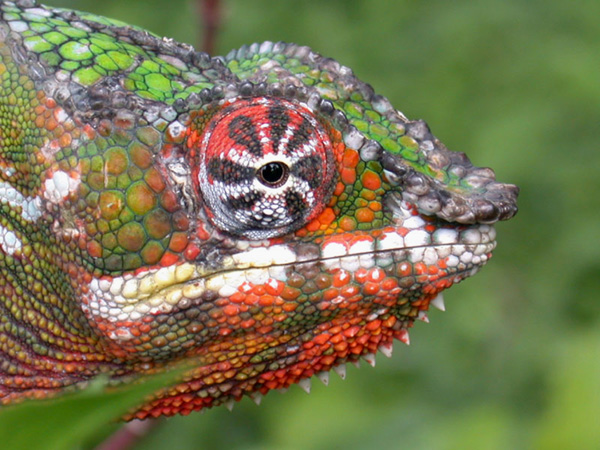 Bent-toed geckos (Genus Cyrtodactylus, i.e. C. louisiadensis and C. irianjayaensis) are becoming ever more popular in captivity but, while a fascinating group, their care is often fraught with difficulties, and there is a great deal of conflicting information being circulated. A recent note from blog reader Dave, upon whom I can always count for interesting comments and questions, brought these wonderful creatures to mind again.
Bent-toed geckos (Genus Cyrtodactylus, i.e. C. louisiadensis and C. irianjayaensis) are becoming ever more popular in captivity but, while a fascinating group, their care is often fraught with difficulties, and there is a great deal of conflicting information being circulated. A recent note from blog reader Dave, upon whom I can always count for interesting comments and questions, brought these wonderful creatures to mind again.
Dave noted the scarcity of husbandry information regarding bent-toed geckos, and mentioned that his lizard, purchased as a giant bent-toed gecko, was not feeding with very much vigor. Following are some exerts from my response to Dave, along with a few additional notes.
The Genus Cyrtodactylus
So far, 115 species have been described in the genus Cyrtodactylus. The giant bent-toed gecko is often sold as the “New Guinea phase” of C. louisiadensis, but is actually a separate species, C. irianjayaensis. To further confuse matters, stores sometimes mix up the various species, and coin their own names.
There are still many questions as regards the husbandry and natural history of the giant bent-toed gecko. Over the years, I’ve had a number of little known species of the same genus (Cyrtodactylus) pass through my hands, and have found the following general principles to be of use.
The Importance of a Secure Environment
Give the animal as much space as possible, with lots of cover and places to climb…suspended pieces of rolled cork bark make perfect shelters. Bent-toed geckos are very stress-prone, but don’t always exhibit the behavioral signs of stress – flight, panting, threat displays – so commonly seen in other lizards; disturb it as little as possible. These are definitely animals to observe, not handle. A night-viewing bulb will allow you to watch the lizard as it goes about its nocturnal wanderings without undue disturbance.
Providing Security
One useful technique that works with animals of all types is to provide a solid wall or two. You may notice that well-run zoos rarely exhibit animals in cages having all sides are open to view.
In an aquarium, you can cover some of the glass with dark paper or cardboard. Even where shelters are available, this simple step often makes a great difference in the animal’s welfare, and brings about immediate changes in its behavior.
Next time I’ll cover lighting and feeding, including a note on the use of snails in the diet of this and related geckos.
Further Reading
A listing of all species with the genus Cyrtodactylus, along with range information, may be found at
http://www.jcvi.org/reptiles/search.php?submit=Search&exact%5B%5D=genus&genus=Cyrtodactylus
The image pictured above was referenced from Wikipidia and features a related species; not the Giant Bent Toed Gecko. Originally posted by W.A. Djatmiko.
 That Reptile Blog – Reptile, Amphibian and Exotic Pet Care and Information
That Reptile Blog – Reptile, Amphibian and Exotic Pet Care and Information

 Raccoons, although native, have also become problematical in recent years. Now well adjusted to people, they thrive everywhere…during my years as a nuisance wildlife trapper, I caught scores throughout NYC, including in some of Manhattan’s most densely-populated neighborhoods.
Raccoons, although native, have also become problematical in recent years. Now well adjusted to people, they thrive everywhere…during my years as a nuisance wildlife trapper, I caught scores throughout NYC, including in some of Manhattan’s most densely-populated neighborhoods. Chameleons with high Vitamin D3 levels (achieved through a diet of vitamin-supplemented crickets) limited their exposure to the sun, while those maintained on a vitamin-poor diet maximized basking time. Further analysis showed that, as regarded individual Vitamin D3 levels, the lizards were “…as effective as mathematically possible” in achieving optimal sun exposure. Vitamin D3 receptors in the brain are believed responsible for accessing vitamin needs and controlling basking behavior.
Chameleons with high Vitamin D3 levels (achieved through a diet of vitamin-supplemented crickets) limited their exposure to the sun, while those maintained on a vitamin-poor diet maximized basking time. Further analysis showed that, as regarded individual Vitamin D3 levels, the lizards were “…as effective as mathematically possible” in achieving optimal sun exposure. Vitamin D3 receptors in the brain are believed responsible for accessing vitamin needs and controlling basking behavior. Chameleon fanciers are indeed fortunate that the chameleon best suited for captivity, the veiled or concave-casqued chameleon (Chamaeleo calyptratus) is also among the most beautiful and interesting of the group (it is also pathologically anti-social, but so are most of its relatives!). Turquoise, emerald green, yellow and tan, each in many shades, all find a place in this lizard’s repertoire of color changes. Male veiled chameleons approach 2 feet in length while females top out at about 14 inches.
Chameleon fanciers are indeed fortunate that the chameleon best suited for captivity, the veiled or concave-casqued chameleon (Chamaeleo calyptratus) is also among the most beautiful and interesting of the group (it is also pathologically anti-social, but so are most of its relatives!). Turquoise, emerald green, yellow and tan, each in many shades, all find a place in this lizard’s repertoire of color changes. Male veiled chameleons approach 2 feet in length while females top out at about 14 inches.